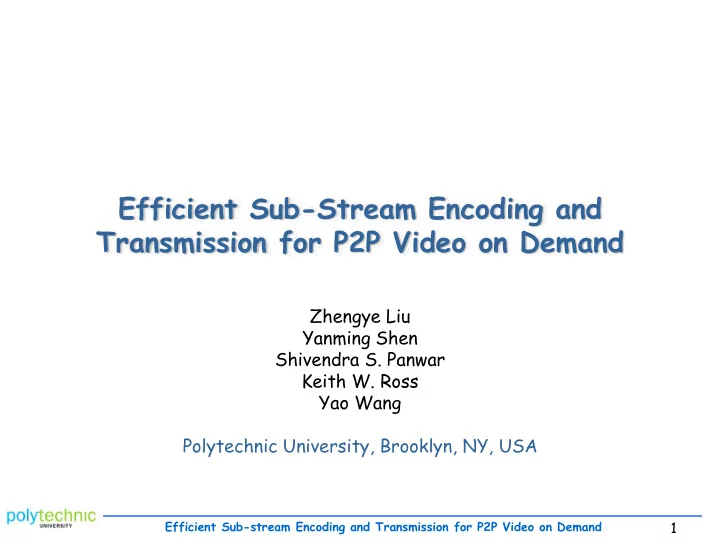

Efficient Sub-Stream Encoding and Transmission for P2P Video on Demand Zhengye Liu Yanming Shen Shivendra S. Panwar Keith W. Ross Yao Wang Polytechnic University, Brooklyn, NY, USA Efficient Sub-stream Encoding and Transmission for P2P Video on Demand 1
Outline • Motivation • P2P VoD system • Sub-stream encoding and transmission • Simulations • Conclusion Efficient Sub-stream Encoding and Transmission for P2P Video on Demand 2
Motivation • Video-on-demand services – Youtube, MSN video, google video,… – Content distribution networks (CDNs) • P2P live streaming systems – PPLive, PPStream, UUSee, Coolstreaming,… – Support thousands of users simultaneously Efficient Sub-stream Encoding and Transmission for P2P Video on Demand 3
P2P VoD System • Multiple video architecture – Extension of CDNs: Peers act as video servers – Contribute storage in addition to bandwidth – Help each other with stored videos Efficient Sub-stream Encoding and Transmission for P2P Video on Demand 4
Proposed System with Multiple Sub-Streams In this illustration, two simultaneous streaming sessions are requested from nodes 4 and 5. The system initially selects nodes 2 and 3 to serve node 4’s request, and selects nodes 4 and 1 to serve node 5’s request. After Node 2 goes down, the system finds node 6 as a replacement Efficient Sub-stream Encoding and Transmission for P2P Video on Demand 5
Benefit of Using Layered Coding/MDC • Adaptive to the long-term bandwidth fluctuation due to peer churn – Uplink bandwidth fluctuation – Received video quality adapts to the available uplink bandwidth • Robust to peer failure/disconnection – One supplier failure only affects one/several sub- stream(s) – Video quality will not be impaired seriously Efficient Sub-stream Encoding and Transmission for P2P Video on Demand 6
Multi-Stream Coding Schemes (a) Layered coding (b) MDC (c) Ideal scheme – Compare schemes (a), (b) – Design (c) Efficient Sub-stream Encoding and Transmission for P2P Video on Demand 7
Push-Pull Delivery with Layered Coding • Store all layers of a video • Push-pull for layer delivery • Storage consumed for one video: RM Efficient Sub-stream Encoding and Transmission for P2P Video on Demand 8
The Ideal Scheme should consume minimum storage • Can we reduce the consumed storage? • The minimum storage: R+R/2+,…,+R/M ≈ R ln(M) Efficient Sub-stream Encoding and Transmission for P2P Video on Demand 9
RS Coding RS (8,2) coding for Layer 2 Any two received chunks can recover the original two chunks Efficient Sub-stream Encoding and Transmission for P2P Video on Demand 10
RS Coding Instead of Replicating RS (8,k) coding, k=1,2,3,4 Efficient Sub-stream Encoding and Transmission for P2P Video on Demand 11
Redundancy-Free Transmission Based on Push-Pull Architecture R • A receiver schedules the chunks that should be delivered (Pull) • A supplier pushes the chunks based on the schedule (Push) Efficient Sub-stream Encoding and Transmission for P2P Video on Demand 12
Features of Proposed Scheme • Ideal Scheme – Equal importance (like MDC) – Redundancy free transmission (like Layered coding) • Minimum storage consumed – R ln(M) vs. RM • M=4, 2.08R vs. 4R, save about 50% • M=32, 3.47R vs. 32R, save about 89% • Since a peer needs to store fewer substreams: save server bandwidth Efficient Sub-stream Encoding and Transmission for P2P Video on Demand 13
Simulations • Setting – 3000 peers, different uplink bandwidth – 30 videos, different popularity (Zipf distribution with parameter 0.27) • Simulate two video sequences – Foreman: low rate – Mobile: high rate • Compare SLRS, Layered Coding, MD-FEC, RFMD • Performance metrics – Discontinuity: number of undecodable GOPs/Total number of GOPs – PSNR Efficient Sub-stream Encoding and Transmission for P2P Video on Demand 14
Simulation Results Discontinuity of different schemes PSNR of different schemes vs. number of active users under the “Foreman” sequence vs. number of active users under the “Foreman” sequence Efficient Sub-stream Encoding and Transmission for P2P Video on Demand 15
Simulation Results Discontinuity of different schemes PSNR of different schemes vs. number of active users under the “Mobile” sequence vs. number of active users under the “Mobile” sequence Efficient Sub-stream Encoding and Transmission for P2P Video on Demand 16
Conclusion • Propose a redundancy-free transmission scheme based on a push-pull architecture • RFMD – Advantages • All substreams have equal importance: graceful quality degradation • Only the source bits are transmitted: no transmission redundancy • Coding instead replication: any combination of M or fewer substreams can be used in reconstructing video – Additional cost: • Feedback from the client to each supplying peer: feasible in typical P2P VoD applications Efficient Sub-stream Encoding and Transmission for P2P Video on Demand 17
Thanks! Efficient Sub-stream Encoding and Transmission for P2P Video on Demand 18
Recommend
More recommend